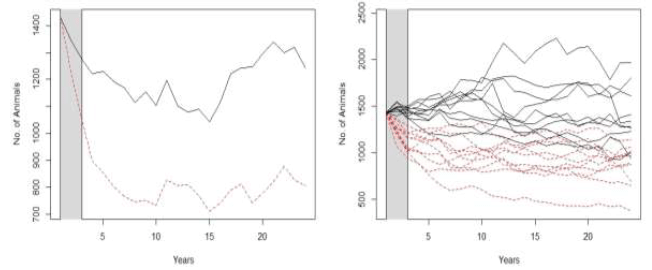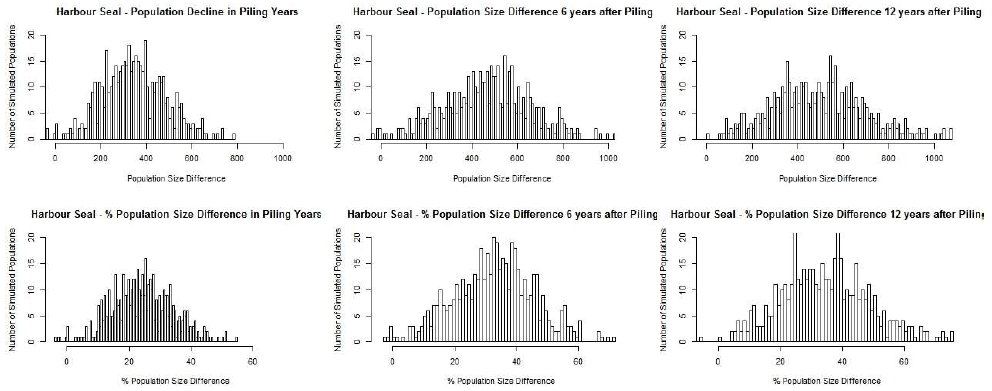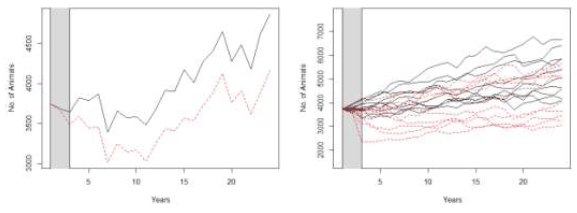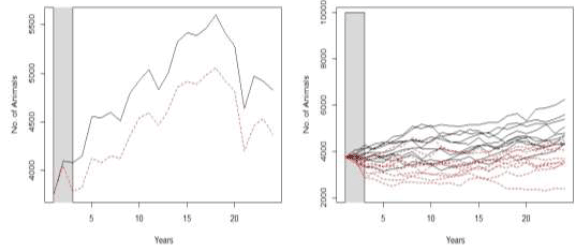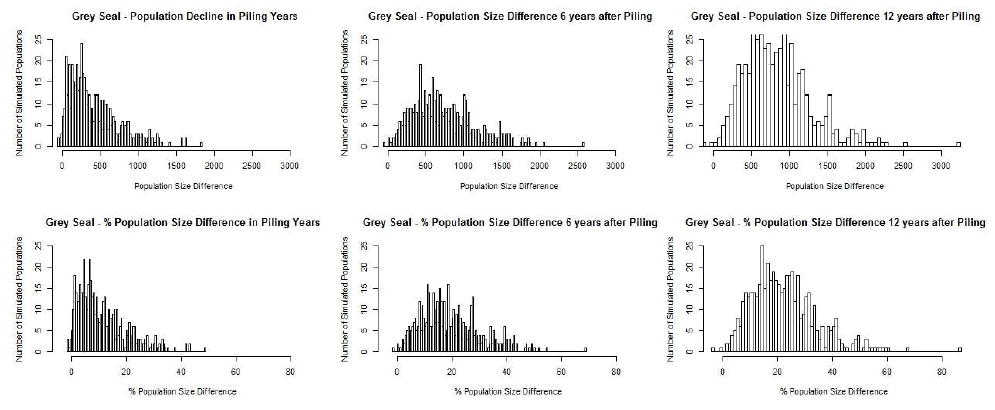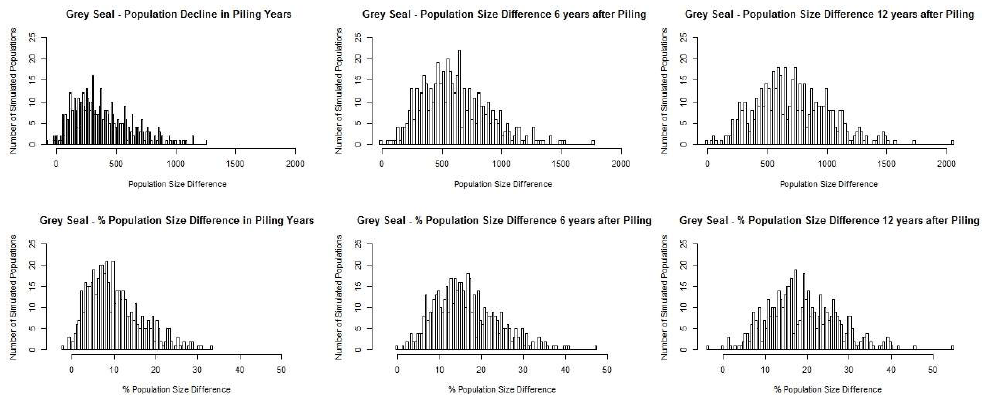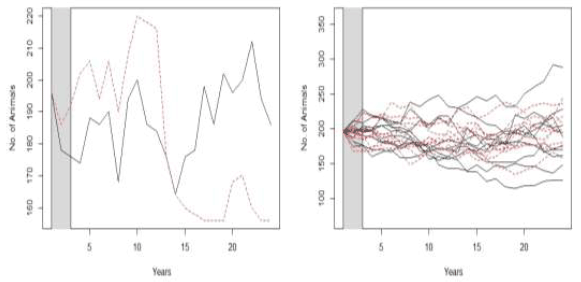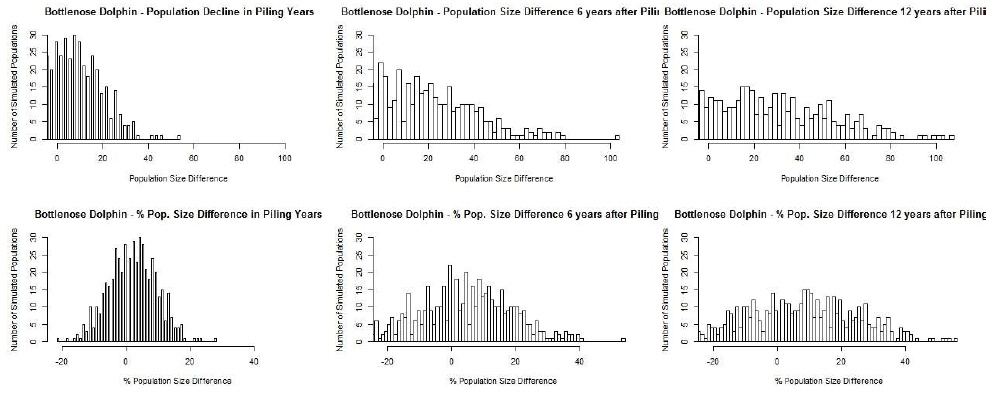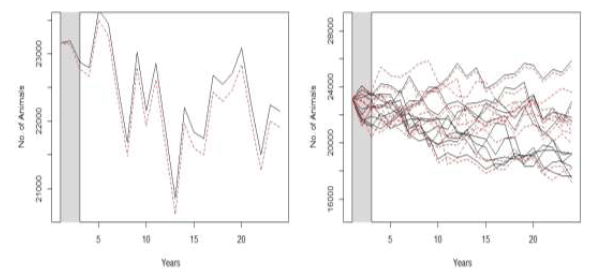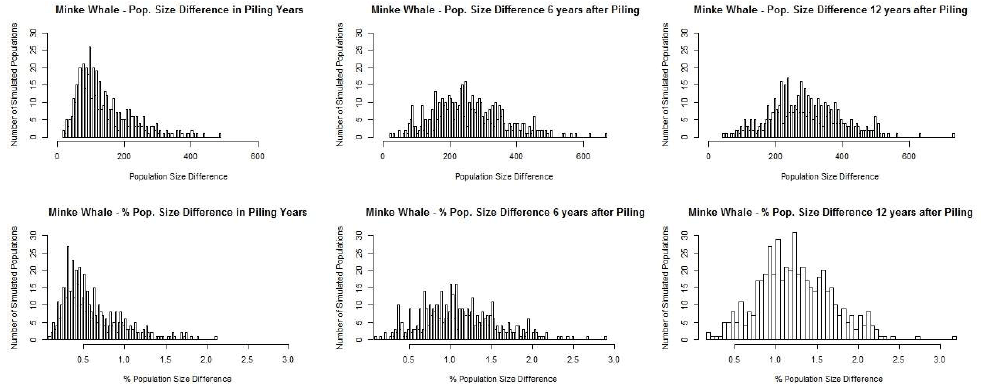Scottish Marine and Freshwater Science Volume 5 Number 2: A Protocol for Implementing the Interim Population Consequences of Disturbance (PCoD) Approach...
Report on developing a protocol to implement the interim Population Consequences of Disturbance (PCoD) Approach: quantifying and assessing the effects of UK offshore renewable energy developments on marine mammal populations
Appendix 3: Detailed Results from Scenarios for Other Priority Species
Moray Firth Harbour Seals
Figure A3.1. Examples of the predicted changes in abundance of the harbour seal population in the Moray Firth MU in the 24 years following the construction of two hypothetical wind farms. The left panel shows the trajectory of one disturbed population (shown as red dotted line) and the matching undisturbed population (shown as black solid line). The right panel shows the trajectories of 10 disturbed (shown as red dotted lines) and undisturbed (shown as black solid lines) populations.
Figure A3.2 The predicted effects of disturbance and injury associated with the construction of two hypothetical wind farms on 500 simulated harbour seal populations when all of the population is vulnerable to the effects associated with both wind farms. Upper panels show the predicted differences between the size of the undisturbed and disturbed populations immediately after construction, and at 6-year intervals thereafter. Positive values indicate that the disturbed population is smaller than the undisturbed one. The lower panels show these differences expressed as a percentage of the initial population size. Moray Firth Grey Seals
Figure A3.5 Examples of the predicted changes in abundance of the grey seal population in the 24 years following the construction of two hypothetical wind farms when all of the population is considered vulnerable. The left panel shows the trajectory of one disturbed population (shown as red dotted line) and the matching undisturbed population (shown as black solid line). The right panel shows the trajectories of 10 disturbed (shown as red dotted lines) and undisturbed (shown as black solid lines) populations.
Figure A3.6 Examples of the predicted changes in abundance of the grey seal population in the 24 years following the construction of two hypothetical wind farms when 50% of the population is considered vulnerable. The left panel shows the trajectory of one disturbed population (shown as red dotted line) and the matching undisturbed population (shown as black solid line). The right panel shows the trajectories of 10 disturbed (shown as red dotted lines) and undisturbed (shown as black solid lines) populations.
Figure A3.7 The predicted effects of disturbance and injury associated with the construction of two hypothetical wind farms on 500 simulated grey seal populations when all of the population is vulnerable to the effects associated with both wind farms. Upper panels show the predicted differences between the size of the undisturbed and disturbed populations immediately after construction, and at 6-year intervals thereafter. Positive values indicate that the disturbed population is smaller than the undisturbed one. The lower panels show these differences expressed as a percentage of the initial population size.
Figure A3.8 The predicted effects of disturbance and injury associated with the construction of two hypothetical wind farms on 500 simulated grey seal populations when 50% of the population is vulnerable to the effects associated with both wind farms and the remaining 50% is not affected. Upper panels show the predicted differences between the size of the undisturbed and disturbed populations immediately after construction, and at 6-year intervals thereafter. Positive values indicate that the disturbed population is smaller than the undisturbed one. The lower panels show these differences expressed as a percentage of the initial population size.
East Coast Scotland Bottlenose Dolphins
Figure A3.9 Examples of the predicted changes in abundance of the grey seal population in the 24 years following the construction of two hypothetical wind farms when 50% of the population is considered vulnerable. The left panel shows the trajectory of one disturbed population (shown as red dotted line) and the matching undisturbed population (shown as black solid line). The right panel shows the trajectories of 10 disturbed (shown as red dotted lines) and undisturbed (shown as black solid lines) populations.
Figure A3.10 The predicted effects of disturbance and injury associated with the construction of two hypothetical wind farms on 500 simulated bottlenose dolphin populations when 50% of the population is vulnerable to the effects associated with both construction sites and the remaining 50% of the population is not affected by either operation. Upper panels show the predicted differences between the size of the undisturbed and disturbed populations immediately after construction, and at 6-year intervals thereafter. Positive values indicate that the disturbed population is smaller than the undisturbed one. The lower panels show these differences expressed as a percentage of the population size before the start of construction.
Minke Whales
Figure A3.11 Examples of the predicted changes in abundance of the minke whale population in the 24 years following the construction of two hypothetical wind farms when 10% of the population is considered vulnerable and the other 90% is considered to be unaffected by the development. The left panel shows the trajectory of one disturbed population (shown as red dotted line) and the matching undisturbed population (shown as black solid line). The right panel shows the trajectories of 10 disturbed (shown as red dotted lines) and undisturbed (shown as black solid lines) populations.
Figure A3.12 The predicted effects of disturbance and injury associated with the construction of two hypothetical wind farms on 500 simulated minke whale populations when 10% of the population is vulnerable to the effects associated with both construction sites and the remaining 90% of the population is not affected by either operation. Upper panels show the predicted differences between the size of the undisturbed and disturbed populations immediately after construction, and at 6-year intervals thereafter. Positive values indicate that the disturbed population is smaller than the undisturbed one. The lower panels show these differences expressed as a percentage of the population size before the start of construction.
Contact
There is a problem
Thanks for your feedback
